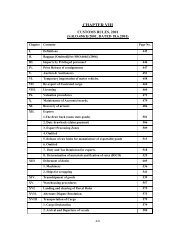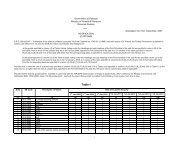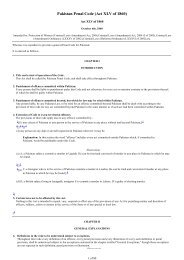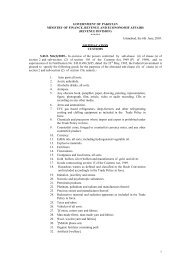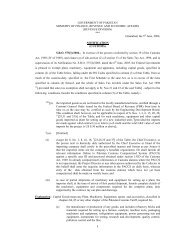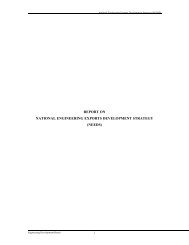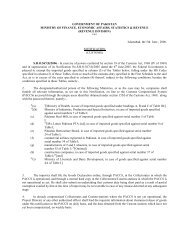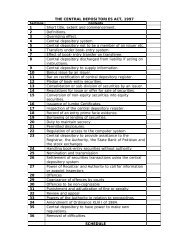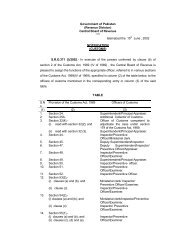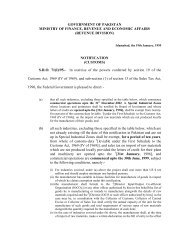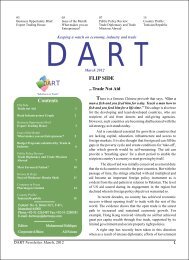47. Pakistan Economic Survey 2011-12 - Consultancy Services in ...
47. Pakistan Economic Survey 2011-12 - Consultancy Services in ...
47. Pakistan Economic Survey 2011-12 - Consultancy Services in ...
Create successful ePaper yourself
Turn your PDF publications into a flip-book with our unique Google optimized e-Paper software.
<strong>Pakistan</strong> <strong>Economic</strong> <strong>Survey</strong> <strong>2011</strong>-<strong>12</strong>Table 4.2: Structure of Federal Tax Revenue (Rs. Billion)YearTax Rev as % DirectIndirect TaxesTotal (FBR)of GDP Taxes Customs Sales Excise Total[39.4] {25.8} {60.3} {14.0} [60.6]2007-08 1,008.1 9.8387.9 150.7 377.4 92.1 620.2[38.5] {24.3} {60.9} {14.9} [61.5]2008-09 1,161.1 9.1443.5 148.4 451.7 117.5 717.6[38.2] {20.7} {62.9} {16.4} [61.8]2009-10 1,327.4 9.0526.0 160.3 516.3 <strong>12</strong>4.8 801.4[39.6] {20.0} {64.4} {15.6} [60.4]2010-11 1,558.2 8.6602.5 184.9 633.4 137.4 955.7[38.7] {19.3} {66.3} {14.4} [61.3]<strong>2011</strong>-<strong>12</strong>B 1,952.0 9.5745.0 215.0 852.0 140.0 <strong>12</strong>07.0[38.2] {17.8} {70.6} {11.6} [61.8]Source: Federal Board of Revenue[ ]as % of total taxes{ } as % of <strong>in</strong>direct taxesUnder the present tax system, some sectors areunder-taxed and others are not taxed at all. Thisdistortion is be<strong>in</strong>g addressed. Moreover, the<strong>in</strong>ternal tax system has undergone substantialchanges as the share of <strong>in</strong>come tax has risensignificantly from around 32 percent <strong>in</strong> 2000-01 to38.2 percent <strong>in</strong> <strong>2011</strong>-<strong>12</strong>. On the other hand thecomposition of taxes has been rationalized with agradual decrease <strong>in</strong> the dependence on foreigntrade taxes and a simultaneous <strong>in</strong>crease <strong>in</strong> GST.Customs and excise duties have registered agradual decl<strong>in</strong>e on account of the tax and tariffreforms with excise and custom compris<strong>in</strong>g only8.5 percent and 10.6 percent respectively <strong>in</strong> <strong>2011</strong>-<strong>12</strong>. <strong>Pakistan</strong>’s tax to GDP ratio stood at around 8.6percent <strong>in</strong> 2010-11 and expected to be about 9.5percent of GDP <strong>in</strong> <strong>2011</strong>-<strong>12</strong>. The <strong>in</strong>direct tax toGDP ratio stood at around 5.3percent and directtax to GDP ratio at around 3.3 percent <strong>in</strong> 2010-11.Dur<strong>in</strong>g July-April, <strong>2011</strong>-<strong>12</strong> <strong>in</strong>direct tax to GDPratio stood at 4.3 percent and direct tax to GDPratio recorded at 2.6 percent. The ratio can only be<strong>in</strong>creased substantially if the major contributors toGDP growth not <strong>in</strong>cluded <strong>in</strong> the tax net can bebrought <strong>in</strong>to the tax system.Tax ReformsThe low tax-to-GDP ratio restricts the country’sability to counter <strong>in</strong>flation, deliver quality publicservices or improve human resources to reach atake-off stage for economic development. Toaddress this issue and others <strong>in</strong>clud<strong>in</strong>g debtservic<strong>in</strong>g and defense needs, the government hasplaced Tax Adm<strong>in</strong>istration high on its reformagenda.Reform StrategyThe reform strategy had three ma<strong>in</strong> planks (a)policy reforms, (b) adm<strong>in</strong>istrative reforms and (c)organizational reforms. The policy reforms <strong>in</strong>cludesimpler laws, universal self-assessment,elim<strong>in</strong>ation of exemptions, less dependence onwithhold<strong>in</strong>g taxes and effective dispute resolutionmechanism. The adm<strong>in</strong>istrative reforms aim (i) totransform <strong>in</strong>come tax organization on functionall<strong>in</strong>es; (ii) re-eng<strong>in</strong>eer manual processes of all taxeswith the aim to reduce face to face contact betweentaxpayers and tax collectors, <strong>in</strong>crease effectivenessof FBR, and improve skills and <strong>in</strong>tegrity of theworkforce and facilitation of taxpayers. Theorganizational reforms also <strong>in</strong>cluded reorganizationof the FBR on functional l<strong>in</strong>es,reduction <strong>in</strong> number of tiers and reduction <strong>in</strong> theworkforce.In pursuance of tax reforms FBR has been restructuredon functional l<strong>in</strong>es. With a view tosupplement the level of skills <strong>in</strong> the FBR, thegovernment <strong>in</strong> March-April, 2001 appo<strong>in</strong>tedprofessional members from private sector for (i)Human Resource Management (HRM), (ii)Information Management System (IMS), (iii)Audit, (iv) Facilitation and Taxpayers Education(FATE) and (v) Fiscal Research and Statistics(FR&S). The FBR has prepared a new recruitmentpolicy (with greater emphasis on skills that match56



